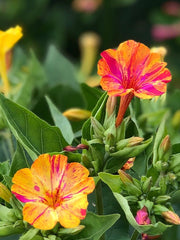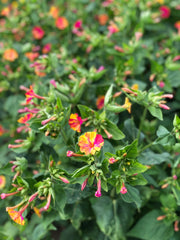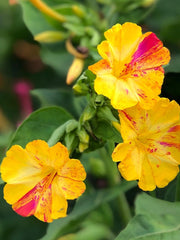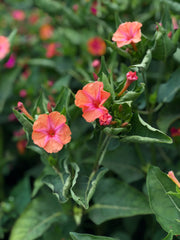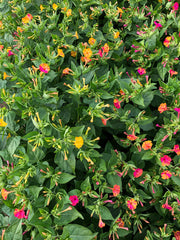Four O'Clocks, 'Strega'
(Mirabilis jalapa) This botanical party originally came to us from our dear friend and collaborator Lane Selman of the Culinary Breeding Network who gathered the seed from wild roadside plants in the village of Castiglione di Sicilia - north of Mount Etna in northeastern Sicily, close to her familial home.
She writes
"I love these flowers as they remind me of my Sicilian grandmother who always had them in her yard in Florida where they are perennial plus self seed prolifically.
Although my grandmother only had the common solid hot pink/purple variety, a cool thing about them is they can have flowers with different colors growing simultaneously on the same plant. Some flowers have splashes and streaks of multiple colors on individual blooms. And it’s possible to have different combinations of flowers and patterns occurring on different flowers of the same plant.
The name "four-o'clock” comes from the flowers opening in the late afternoon or early evening (between 4:00-8:00). The blooms produce a strong, sweet-smelling fragrance throughout the night which attracts Sphingidae moths and other nocturnal pollinators which pollinate during the night before the flowers close for good in the morning. New flowers open the next day.
These plants are originally from tropical South America and arrived in Europe in 1525 as an ornamental species. In Italy they are called 'bella di notte', which means 'beautiful during night'.
Plants stand about 4' and are covered with blooms, from hot pinks to electric salmons to neon yellows and any streaked combination of the three. The name "Strega" is Italian for "witch" and is an apt descriptor for the genetic sorcery that is at play in the plants. Much of the unpredictability of pattern and coloration in the blooms is a result of transposons (or "jumping genes") which move around chromosomes disrupting what would normally be predictable color expression with wild splashes of patterning and color.
The first in our new "Random Italian roadside 4 o'clock biodiversity project" in partnership with the Culinary Breeding Network. Annual in zones 7- and possible perennial (tubers) in zones 8+.
80 days. UO
Packet: 20 seeds
Availability: In stock
Growing Info
SOWING:
Sow indoors 4-6 weeks before your last frost.
Transplant after last frost (soil temp around 65F)
Direct sow after last frost when soil temps are 65F
Note: May self-sow but not aggressively. If you are concerned, deadhead often! If you are having trouble with germination, you may nick the seeds and soak overnight before sowing.
PLANTING DEPTH:
1/4"
SPACING:
2'
EMERGENCE:
7-14 days @ soil temp 65-75F
LIGHT:
Full sun to mostly full sun
FERTILITY:
Average. Prefers well-drained, and evenly moist soil but are drought, heat, and poor soil tolerant.
ADDITIONAL NOTES:
While not absolutely necessary, you may provide staking or netting to keep them upright and tidy. They do tend to support each other and have a lovely upright habit.
You may pinch them, but honestly they need very, very little from you.
Drought, heat, and poor soil tolerant.
Rabbit and Deer resistant.
Attract hummingbirds, butterflies, and nocturnal pollinators! Flowers open late afternoon and remain open until morning.
Tubers may be dug for storage (like dahlias) or left in the ground depending on your zone (zone 8+).
Love them in the garden as they are not suitable for cutting.






